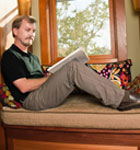Joseph M. Bennett has been practicing architecture in Austin, Texas, since 1985. After a career in commercial architecture, Bennett made the switch to residential when he opened his own office in 1998. This switch also allowed him to refocus on energy efficiency—a personal priority that took a backseat while designing airports for his previous employer. His office quickly grew to six full-time employees, with many projects featured on the Austin Cool House Tour, the AIA Austin Homes Tour, and the National Association of the Remodeling Industry Tour. Here, he talks about the secrets of his success.
Does your personality come out in your work?
My dedication to energy efficiency is the part of my personality that shines through the most. Otherwise, I want to reflect the client’s personality; where they live represents them, and my goal is to accommodate my client’s lifestyle and to enhance that lifestyle.
Who’s your design hero?
I admire a lot of great architects—those who create designs that respond well to the site or who resolve some programmatic design problem. I research more styles than I do architects. If I’m working on an Arts and Crafts house,then I’ll look at Frank Lloyd Wright and Greene & Greene. One quote that recently resounded with me was from Edmund Bacon, who was an architect in Philadelphia and Kevin Bacon’s father: “It’s in the doing that the idea comes.”
What did you enjoy most about working on the Lake LBJ Residence?
That was one of those projects where you have wonderful clients who trust you to provide all the design ideas and thoughts. I got to do all the interior design and tile work and helped them with the selection of the light fixtures, the hardware on the cabinetry, and the finishes. I really enjoy the … challenge in pulling together an entire house from top to bottom.
——————————————————————————————————————————————————————
HOMES OF NOTE


1/ The Lake LBJ Residence features rift-sawn oak cabinetry and eco-friendly countertops.
2/ The home was envisioned as a modern, energy-efficient retreat, with douglas fir columns, large roof overhangs, and spray-foam insulation.
3/ A view of the living room from above shows the hickory pecan wood flooring.
4/ Bennett’s own home, the Deep Eddy Avenue House, also features warm wood and was featured on Austin’s Cool House Tour.
5/ Bennett’s goal for the Deep Eddy house was to restore the appeal of the Arts and Crafts bungalow, while also making it extremely energy efficient.

——————————————————————————————————————————————————————
Did you use your own home [the Deep Eddy Avenue House] to showcase your attitude toward energy efficiency?
Yes, I think I did. By implementing all the various products that you usually recommend, it allows you to be able to say to clients, “Yes, it works. I’ve used it in my house.”
What did you put into the house?
Every architect needs to build their own house as a learning experience for the contractor side. I applied rigid insulation to the outside, spray-foam polyurethane in the ceilings, finger-jointed studs for 50 percent of the framing, and low-E windows. I incorporated local woods, finishes and paints with no VOCs, recycled materials like glass flooring, and cork flooring in a third-floor loft. I used Lyptus [a cross between two species of eucalyptus tree] for a lot of cabinetry in the house. You can stain it to look like mahogany,weand it has a lot character.
Tell me about the Treadwell House project.
This was one of the first projects that we ran through the [Austin Energy] Green Building program, and it achieved a five-star rating, their highest award. A little background on the house: the owner had a fire in the house on Thanksgiving. He just wanted to rebuild it as it was, and I recommended improving upon it, especially as it was a very old, inefficient house. The first thing we thought of was using ICF—insulated concrete form. It creates an amazingly high R-value, and energy efficiency combined with [fire-resistant] concrete gave the owner that comfort concerning future Thanksgivings. According to the Green Building program statistics, it turned out to be one of the most energy-efficient houses in Austin.
What’s the Cool House Tour?
The Green Building program is one of the most preeminent programs in the country—it’s been running since the ’70s. Green building has historically been associated with a hippie mentality and [has not been] expected to be of high design. The Cool House Tour wants to show you that that’s not the case.
Why do you think that they featured the Deep Eddy Avenue House?
What I think appealed to them about that house was that it doesn’t look like the idea of a green house. And that’s something that I love—taking a style or design and using the materials, wall systems, finishes, and all that sort of stuff. When someone comes in, they don’t pigeonhole it as a type. They just think “Wow, this is a great space.”
What are your long-term goals as an architect?
The goal is to continue using the latest technologies and incorporating them into the house designs while maintaining a high level of style. And to build a house that is totally off the grid—and ideally put that together with no one walking in and going, “Oh, this is a house off the grid.” I like subtlety, and it takes a little bit of work to achieve that.

